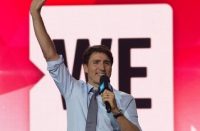My assumption is that anyone who clicks on this column takes voting the environment seriously. You likely plan to vote for the candidate of one of three parties (Green, Liberal or NDP). There are differences among the three in terms of environmental policy, but those differences are much smaller than the differences between any one of the three and the Conservative Party. This has not always been so and may not be so in the future, but it is so now. In 2015 that difference is enormous.
My assumption is that anyone who clicks on this column takes voting the environment seriously. You likely plan to vote for the candidate of one of three parties (Green, Liberal or NDP). There are differences among the three in terms of environmental policy, but those differences are much smaller than the differences between any one of the three and the Conservative Party. This has not always been so and may not be so in the future, but it is so now. In 2015 that difference is enormous.
I am going to argue then that voting with environmental issues as a priority in this election means one should consider voting strategically (unless, perhaps, you live in a riding where the outcome is a foregone conclusion). I would first suggest being sure that that outcome really is a foregone conclusion this time too: remember Alberta, of all places, just elected an NDP government, not the sort of thing one might expect based on previous outcomes.
Strategic voting means thinking about four factors:
1) Polls (national, provincial and especially local)
2) Riding voting history
3) Local candidate strengths and weakness
4) Special local factors
One of my own riding’s (Peterborough, Ontario) ‘special local factors’ is that our (Conservative) federal member resigned recently after being arrested for election financing irregularities. One might assume that this will influence the local outcome this time around, but I am still carefully watching the polls right down to sample size.
Peterborough is a swing riding; it has recently elected candidates from each of the three parties both provincially and federally. Therefore we are polled often. There have been two riding specific polls so far. In both the Liberal candidate was well ahead — at 41 percent with the other two big parties at about 30 percent and the Greens at 4 percent. It is also important that there are a lot of “Don’t Knows” (at 27 percent). My guess (and it is just a guess) is that a lot of these are undecided between the Liberals and the NDP (given the ‘special factor’), but the “Don’t Knows” could be Conservatives who will not admit to Conservative-leaning uncertainty when the last person they voted for was arrested.
This polling result is consistent with provincial results in Ontario which has the three big parties very close, compared to, say, Quebec or Alberta which lean heavily NDP and Conservative respectively. Down east is leaning Liberal. It is important to check results by province if one’s local poll seems off the mark given provincial results or riding history.
One other factor is crucial: who are your local candidates? Does one of them have the advantage of an incumbent? Where candidates stand on the issues matters, but what matters more for strategic voting decisions is which are especially strong or weak candidates – who can run ahead of party-based outcomes? Sometimes there is no local poll to go on.
An organization is looking to fix the gaps in local polling. Results and plans can be found online at www.Leadnow.ca. This group has polled ten local ridings thus far and hopes to poll most swing ridings (those where the outcome cannot be guessed without a poll). They are crowdsourcing funding for these polls.
Strategic voting is not easy. I have a Ph.D. in Political Science, graduate school certification in polling and statistics and have voted in the same riding for 45 years and ‘got it wrong’ on strategic voting in a recent election. I voted for the candidate who ended up third by a bit when trying to pick who would run closest to the likely (Conservative) winner. You may get it wrong too, but if you try — statistically speaking — your odds of making a difference are higher.
If we all get it right this time we will protect the environment and may also get a new way of voting. It will be some variation on proportional representation where we do not need to worry about this sort of stuff so much. But, alas, for now, we do.
Robert Paehlke is a professor emeritus at Trent University where he taught environmental policy and politics for 35 years. About 40 years ago, he envisioned a magazine that was both scientifically sound and journalistically interesting, and Alternatives was born. “Bob P,” as we call him, sits on the magazine’s editorial board and he contributes articles and blog posts as often as we can trick him into it.
He is the author of Environmentalism and the Future of Progressive Politics (1989), Democracy’s Dilemma: Environment, Social Equity and the Global Economy (2004), Some Like It Cold: The Politics of Climate Change in Canada (2008) and Hegemony and Global Citizenship (2014).













